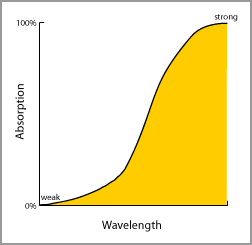|
Spectral resolution describes the ability of a sensor to
detect electromagnetic radiation at fine wavelength intervals. For
example, sensors that can detect energy in a specific, narrow
infrared region can generate imagery which clearly distinguishes
water from ice. Energy emitted from the Earth can only be detected
by the satellite if it is not absorbed by the atmosphere on the way
to the satellite. The black box below represents complete
atmospheric absorption of infrared energy. In other words, for this
specific wavelength no energy reaches the satellite-based sensor and
therefore no image can be produced. Adjust the
slider to see how weaker atmospheric absorption allows better
imagery to be produced. With weak enough absorption, you can begin
to see details of this scene: the Ross Ice Shelf and surrounding
open water with sea ice. The slider and resulting image correlate
with the graphic shown at right.
|

|